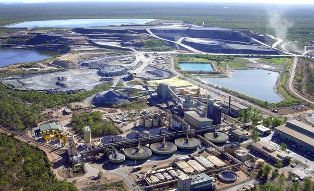A leaching tank has failed at the Ranger uranium mine in Australia, releasing a large volume of acidic slurry mixture. However, owner Energy Resources of Australia (ERA) reported that the spill has been contained within the mine's processing area.
 |
| Ranger (Image: ERA) |
At Ranger's processing plant, uranium ore is ground and processed through a sulfuric acid leach to recover the uranium. During this process, ore slurry is pumped into several leaching tanks into where sulfuric acid and pyrolusite (a manganese-based oxidant) are added to dissolve the uranium in the ore.
At around 1.00am on 7 December, Leach Tank 1 ruptured releasing a mixture of slurry containing mud, water, ore and acid. The tank had a capacity of some 1450 cubic metres.
ERA reported that, due to "multiple levels of protection in place to contain and manage spills," all the slurry mixture was contained within the mine's processing area. The company said that the plant's containment systems - including barriers and channelling - operated as designed during the incident and no injuries occurred. All water monitoring points at the Ranger mine and in the surrounding area have reported normal readings.
The Ranger mine is 260 kilometres east of Darwin in Australia's Northern Territory and surrounded by, but separate from, the Kakadu National Park. While calling the spillage a "significant on-site incident," ERA said that it "is confident that Kakadu National Park will not be impacted as a result of this incident."
General manager of operations Tim Eckersley said, "ERA is focussing on clean up and recovery, and the protection of the environment and the health and safety of our people remains paramount."
Processing operations have now been suspended at Ranger. ERA will commission a full investigation into the incident and is assessing the full impact of the incident on operations, including how long processing operations will be offline and what repairs are required.
Researched and written
by World Nuclear News





_63865.jpg)
_18570.jpg)
_16159.jpg)





